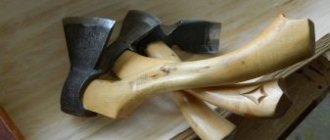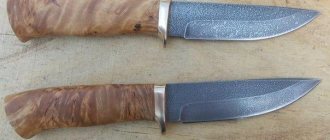When people think of Viking Age weapons, they usually think first of an axe, and the image that forms in their minds is of a huge weapon that could only be wielded by a big, strong man. In reality, axes in the Viking Age were light, fast and well-balanced, and were good for quick, precise, deadly attacks, as well as a variety of clever moves. The battle ax was used by the poorest people during the Viking Age. In general, the ax was used in the household, but in the event of any military operations, the ax was a wonderful weapon for the Vikings.
Let's take a break from history and get down to business. If you are a big fan of Viking Age weapons or just liked the shape of this tool, then we will tell you how to make a Viking ax from an ordinary ax. This tool is very elegant and functional. The ax has a unique shape due to which this tool was first used as a carpenter's tool.
They used such an ax to build their own boats (drakkars). And then, on these boats they set sail and attacked their enemies, killed them and plundered settlements. Now, in peacetime, there is no such need, and such an ax can be made as a decorative element in your country house. We find an old ax in the barn and set out to give it a new life.
The process of making an ax looks like this:
Material selection
The following grades of wood are used for the handle:
- oak;
- birch;
- maple and some others.
In order for this part to be of high quality, the wood must be harvested before frost. After the workpieces are ready, they need to be dried. They should lie in a ventilated area for about a year. But, some craftsmen claim that the drying period should be about 5 years. In fairness, it must be said that in an emergency, you can use an undried workpiece, but this is a temporary option, the handle will quickly wear out.
Cutting out the template
To obtain an ax of the required size, you must use a template made from cardboard. As a sample, to obtain it, you can use the tool that is convenient to work with. That is, you need to put it on a sheet of thick cardboard and outline it with a pencil.
Ax template
By the way, the size of the ax can be determined based on the height and physique of the person who will work with it.
Making a blank
A block is hewn out from a block that has been dried. Work must be carried out along the fibers. The size of the bar should be 100 mm larger than the size of the finished product. The size of the part where it will be installed, and the blade itself should be 2 - 3 mm larger than the size of the eye.
The template prepared in advance must be laid on the surface of the block. At the same time, leave allowances for processing. From the front its size is 10 mm, in the tail it is 90 mm. This allowance is necessary so that the handle does not crack when pulled onto the ax itself. Upon completion of work, this allowance is removed.
Hewing out an ax
To bring the part to the required dimensions, two cuts must be made in the upper and lower parts of the workpiece, but their depth should not reach the contour of 2 mm. Excess material can be removed using a chisel. After this, using a file with a large notch, the corners, transitions and other surfaces of the handle are leveled. Abrasive sandpaper is used to finish the surface.
Making an ax
Impregnation with waterproof compound
To increase the resistance of the handle to moisture, special compounds are used. But it is permissible to use drying oil or linseed oil. The handle is covered with this liquid until it stops being absorbed into it.
By the way, it wouldn’t hurt to add a coloring pigment, for example, orange, to the waterproof coating. Then the tool with a bright handle will not disappear on the site.
Drilling the handle
Next, I drilled holes in the handle and checked that everything fit. The metal part of the handle should act as a spring that will fix the saw blade. If it is too elastic, it can be made thinner. First I used the metal part of the handle as a template to make the holes. Then I fastened the two pads together with clamps and then drilled a through hole. This way all the corresponding holes were in one line.
To connect the parts of the ax without gluing, I used bolts. This way you can check whether all the parts of the ax fit and whether the saw folds correctly.
How to choose an ax?
For a long time in Rus', any man had to be able to wield an ax; each owner had his own tool, the handle of which was like an extension of the hand. Modern axes that are easy to use are made from high-quality materials
You should choose your tool carefully and pay attention to details
The weight of the product plays an important role
When choosing Finnish axes and other professional models, you should pay attention to tools weighing from 2 to 2.5 kg. Lighter axes are inconvenient to use, and heavier axes strain your hands.
The type of ax blade depends on the composition of the wood with which the master will work.
The length of the handle is an important parameter on which the impact force when working with an ax depends.
Army photos on Shutterstock: Army and military photos.
Ax size
The parameters of axes differ depending on their purpose and type. The shape of the blade, the length of the ax and the weight of the tool vary. Standard axes for chopping wood are considered large models; the length of the handle can range from 70 to 100 cm, the thickness of the blade is from 3 to 8 cm, and the weight is from 3.5 to 6 kg. Typical ax models have other characteristics:
- ax length: from 40 to 65 cm;
- sharp edge size: from 10 to 17 cm;
- size of the blunt part: from 4.5 to 7 cm;
- ax height: from 16.5 to 22 cm;
- size of the sharpened part: from 1.4 to 2 cm;
- weight: from 0.7 to 1.6 kg.
Ax blade shape
In home tool stores you can find axes with several types of shafts - wide, which is used for cutting wood, medium, which is considered universal, and narrow, intended for carpentry. The shape of the blade of a large ax can be different:
- Direct
sharpening is necessary for tools used to trim logs and split firewood. - Razor
sharpening is suitable for axes used for shaped cutting. - Oval
- ideal for meat axes used to chop bones; with this sharpening the blade does not get stuck in hard structures. This type of sharpening is good for small carpenter's axes.
Ax blade material
The question of which steel to choose an ax from is one that all craftsmen ask. Axes made of alloy steel are considered the most durable, followed by carbon blades in terms of properties. Alloy alloys, widely used for the manufacture of axes, are currently inferior to modern materials. Weak metals require frequent sharpening; such a tool will last less. When choosing a Scandinavian axe, experts advise hitting something metal with the blade and listening. A clear sound characterizes a quality product.
Ax handle
Axes with a wooden handle have proven themselves to work best. Such instruments experience strong vibration, which is transmitted to the hands. An ax handle made of metal or plastic does not extinguish it, and it is more difficult to work with tourist axes of this type. Birch exhibits the optimal balance of hardness and strength. After several years of use, the tree dries out. You can combat this by placing the ax in water, or purchasing a model treated with paint or varnish. The advantages of non-wooden handles are undeniable, such axes:
- do not rot;
- do not crack;
- do not burn;
- fits comfortably in the hand;
- do not slip thanks to rubber pads.
Blade sharpening
Once the blade's bevel outline was traced, I used an angle grinder with a sanding disc for a rough finish.
Then, for finer work, a file and grinder were used (use water to cool the blade). The final sharpening was done using the grinding wheel of a sharpening machine. I'm not an expert at sharpening an ax blade, so you can do this another way.
The ax will primarily be used to split wood into smaller pieces, so I did a little testing of its functionality.
Final word
There is hardly a man who will not be happy with such a gift. But that's not even the main thing. If a home craftsman once makes such beauty with his own hands, then he will definitely be captivated by the activity, and he won’t be able to stop after that. And with the experience that comes, everything will turn out better and better. For example, you can master the technique of gilding (brass plating). After all, there is no limit to perfection. And if learning brings pleasure, then it will be doubly effective. And regarding such products, it’s not for nothing that experienced blacksmiths say that a beautiful knife or ax is music enclosed in steel...
The Homius editors invite home craftsmen and craftsmen to become co-authors of the “Stories” section. Useful first-person stories will be published on the pages of our online magazine.
Previous STORIES A “floating” heart as a gift to a loved one - original and insanely simple Next STORIES Sleight of hand and a couple of minutes of work: practical ideas for using packaging
Completion
Step-by-step instructions and detailed photos will help you figure out how to make a Viking ax from a simple ax with your own hands. Making this amazing thing is not difficult. But it is important to know how to use the mentioned tools. This ax would make an excellent decoration or gift for a collector.
Related publications
- Read
DIY Viking ax
- Read
How to make a pocket saw from a utility knife
- Read
Sterile toilet paper mask - how to make
- Read
How to make a picture frame from ceiling plinth
- Read
How to make slime with your own hands
- Read
Materials and tools for work
To create an ax similar to the one used by real Vikings, you will need the following materials:
- block (approximately 4x4 cm);
- paper;
- pencil;
- brush;
- wooden wedges;
- varnish (can be replaced with flax oil);
- a small piece of leather material or leatherette (for braiding);
- an ordinary ax (it’s okay if it’s rusty).
A properly selected handle should not subsequently become loose during the drying process if the degree of humidity in the environment changes. If such a need arises, the workpiece must be dried in warm and dry conditions.
It is important to approach the choice of wood for an ax with all responsibility. Only deciduous and only hardwood is suitable
It is also very important to pay attention to the level of drying. The humidity level should not exceed 12%
The following breeds are best suited for making an ax handle:
- beech - has all the necessary qualities, but also has a disadvantage - it absorbs moisture from the air. Therefore, before you start making the handle, you need to further process it;
- oak is a hard, durable and very durable species;
- maple is a very elastic and durable material. The finished handle will have a beautiful texture;
- ash is the best option, since this particular species is known for its strength, durability, and most importantly, affordability. The handle will turn out very beautiful.
The following tools will be required for the job:
- welding machine;
- drill;
- Bulgarian;
- grinding machine.
Having decided on the materials and prepared the tools, you can begin to create a Viking ax.
We make a case for storage and transportation
To make the ax convenient to carry, a special case is made of thick leather or canvas (Figure 11). To do this, it is enough to create a pattern for the future cover and firmly sew the parts together. However, if you are going to wield a large ax in the forest, making a special case for it is impractical, and the tool will have to be carried either without additional protection, or to be sewn separately for the blade.
Figure 11. Options for transport cases
Many hunters and outdoor enthusiasts prefer the latter option, as it makes it easier to carry the tool, which is extremely important if you were making axes yourself and the finished product is quite large in size
Distinctive features
Among the Vikings, axes were in second place after swords in use. It was often a universal tool that could be used in peacetime to cut down trees, chop firewood, and also be used in battle as an excellent weapon. Axes could be one-handed or two-handed, and varied in shape. By the way, this type of ax is similar in design to the domestic taiga one:
Viking axes and taiga ax (right).
- average length of the canvas - 18 cm;
- average width of the canvas - 17 cm;
- the average length of the ax is 90-120 cm;
- canvas weight - up to 450 g.
That is, the width and length of the blade are approximately equal, the blade of such a tool must be thin, the ax itself is quite long to be able to be grasped with two hands (hence the name).
For a better understanding, you can study the structure of the ax in the photo below:
Design.
You may be interested in: DIY forged fence.
Metal hardening
This procedure also consists of several parts at once:
Annealing. First of all, you should dull the edge of the blade by a millimeter. To do this, you need to heat it to about 760 degrees (the metal will acquire a red-burgundy hue) and then slowly cool it. Then remove the scale.
Hardening. You need to heat the blade to 830 degrees and prepare two metal buckets - one should contain just warm water, the other should contain oil. The blade should be lowered into the water for just a couple of seconds and only about 4 cm. And already in the oil - completely
It is important not to forget about safety when working with fire.
Vacation. This stage is important for strengthening the steel
The blade must be cleaned. Vacation should be carried out for an hour at a temperature of approximately 200-300 degrees. Can be done in a regular home oven.
In addition to color changes, the temperature of the blade can be checked with a regular magnet. The cloth will not react to it at temperatures exceeding 768 degrees.
Details of the hardening procedure can be found in the video.
Handle (axe)
- Plane a simple ax handle from a block.
- To decorate it, you can choose any Celtic ornament you like, transfer the drawing with a pencil to the wood and then develop it using a drill.
- To protect the handle from moisture, you need to coat the wood with varnish. As an alternative, you can use flaxseed oil.
Now you can connect the handle to the blade and drive in the pre-prepared wedge.
Braid for ax handle
When the ax itself is ready, all that remains is to make a convenient braid for the handle. It will perform not only protective, but also decorative functions.
How to make a braid:
- Cut a rectangular piece from leather (or leatherette).
- To adjust it to size, you need to wrap the material under the butt.
- It will be easier to work with a piece if you pre-treat it with flax oil - this will soften the fabric.
- Make cutouts according to the shape of the butt for the best fit.
- Make holes for seams closer to the edges of the fabric. You can use an awl or even just a nail.
- Sew the section, securing the material to the ax handle.
- The last step is to treat the braid and handle with oil.
The Scandinavian ax with a Viking Age pattern is completely ready!
see also
Comments 36
My friend, the ax handle is a piece of wood. Did you find the blade)
Great, I’ll make one for myself one of these days too! Good idea!
Old axes are a topic, they don’t sculpt them anymore, I myself only use carpenter’s axes in the forest, I carry them in my belt, that’s why I need a notch in the lower part of the ax. You can also roll a pattern onto the ax handle with a hot bolt with a large thread pitch, for ease of holding in your hands. You've got a good tool!
It turned out great, I didn’t bother so much, I just removed the excess metal from the front end. But this also makes it possible to take it out of the backpack without tearing anything))
Beauty! Have you thought about polishing the ax? To be like a mirror. I saw it not long ago in some video, it looks beautiful, it was also made from an old axe.
No. the idea was to make him look old
Great! The pattern is missing on the ax handle.
Well done! Just a correction, a handle is an ax handle, and an ax is an ax)
But I feel sorry for the axe, the old steel is much better and costs more. In our used market, Soviet instruments cost more than new Bosch and other brands
Great! Beautiful shape, comfortable handle. Let me give you a little advice: don’t use stain. The best effect is obtained by thoroughly cleaning the wooden handle, sanding it with a transition to increasingly fine sandpaper and subsequent opening with impregnation with drying oil (in extreme cases - machine oil). Then - thorough rubbing and polishing until completely dry. Completely waterproof, beautiful color of wood texture, soft and tenacious when gripping by hand!
Try to practice using this coating on some cuttings and you will feel the difference...
Thank you very much for the advice. I'll try
This method was not shown to me - in the manufacture of handles for knives, sapper blades, hammers, etc. And if you still managed to find a good acacia, then in general - such a beauty in texture!
Thank you very much for the advice. I'll try
my 5 cents. The method that my grandfather used and his experience I adopted. I take a bolt with a large thread pitch, heat it red, and roll a pattern on the handle, be it a knife or an ax. It is guaranteed that it will not slip out of your hand during operation.
It turned out to be a good “old school” battle hatchet... For a person... (fixation on the hand, with a rope, through a hole in the ax handle, made independently - machine gun - getting hit by a bladed weapon... And so - beautiful)
I made a rope so that in winter I wouldn’t drown in the presence of ice
yes, this is understandable... and they sell tea models with a hole in the ax handle, but there is like a certificate... just be more careful with the cops now... (you also have the extreme edge changed - “to look like a saber”)
“It’s not the fur coat that warms a man, it’s the axe,” says popular wisdom. An indispensable assistant in the household, the “right hand” of any carpenter - this is all about a completely simple tool called an ax.
Whether it's an ax for the garden or for professional use, the demand for this tool will never go away.
Etching is the most important stage in hatchet making
For etching, it is best to use an inverter welding machine at a minimum current (30 A). As an electrolyte, a solution of water (3.5 l) and salt (700-750 g). Before starting work, it is better to check the intensity of etching on any piece of metal.
PHOTO: YouTube.com The electrolyte is ready, the welder is in place, you can start
Connecting elements to welding wires
First of all, a hatchet is attached to the positive cable, which is completely immersed in the electrolyte. But the negative contact needs some work. To increase the area immersed in the electrolyte, you can use a mounting plate for a metal profile. It should be curved so that the contacts are on both sides of the hatchet.
PHOTO: YouTube.com The mounting plate is perfect for etching
Etching procedure, inspection, protection of the welding machine
Having lowered the negative plate into the electrolyte, you need to make sure that both its sides are equidistant from the hatchet. Only after this can the welding machine be turned on. A violent reaction will begin almost instantly. It looks as if the electrolyte is boiling. In fact, this is not far from the truth; electrolysis does its job. Unpainted metal is etched away. No harm is caused to the painted surface; it remains untouched.
Etching is carried out in 5 passes. The welder turns off every 2 minutes to allow it to rest. It turns out that the total etching time is about 10 minutes. After this, the ax can be removed from the electrolyte.
PHOTO: YouTube.comThe electrolyte first boils and then turns dark
After the required time has passed, the hatchet can be removed from the container and the result can be assessed. If the etching depth seems shallow, you can continue. If everything is in order, then it’s time to remove the paint.
PHOTO: YouTube.comIf the etching depth is satisfactory, you can move on to the next stage
The final part of working with metal
The ax needs to be washed off the salt under running water and dried, then remove the paint from it. This can be done with fine sandpaper or acetone. Next, the entire surface must be polished. A felt circle mounted on an emery board or drill is perfect for this purpose. Only after polishing can you fully evaluate what the result of the work done is.
PHOTO: YouTube.com We can say that it turned out very well











